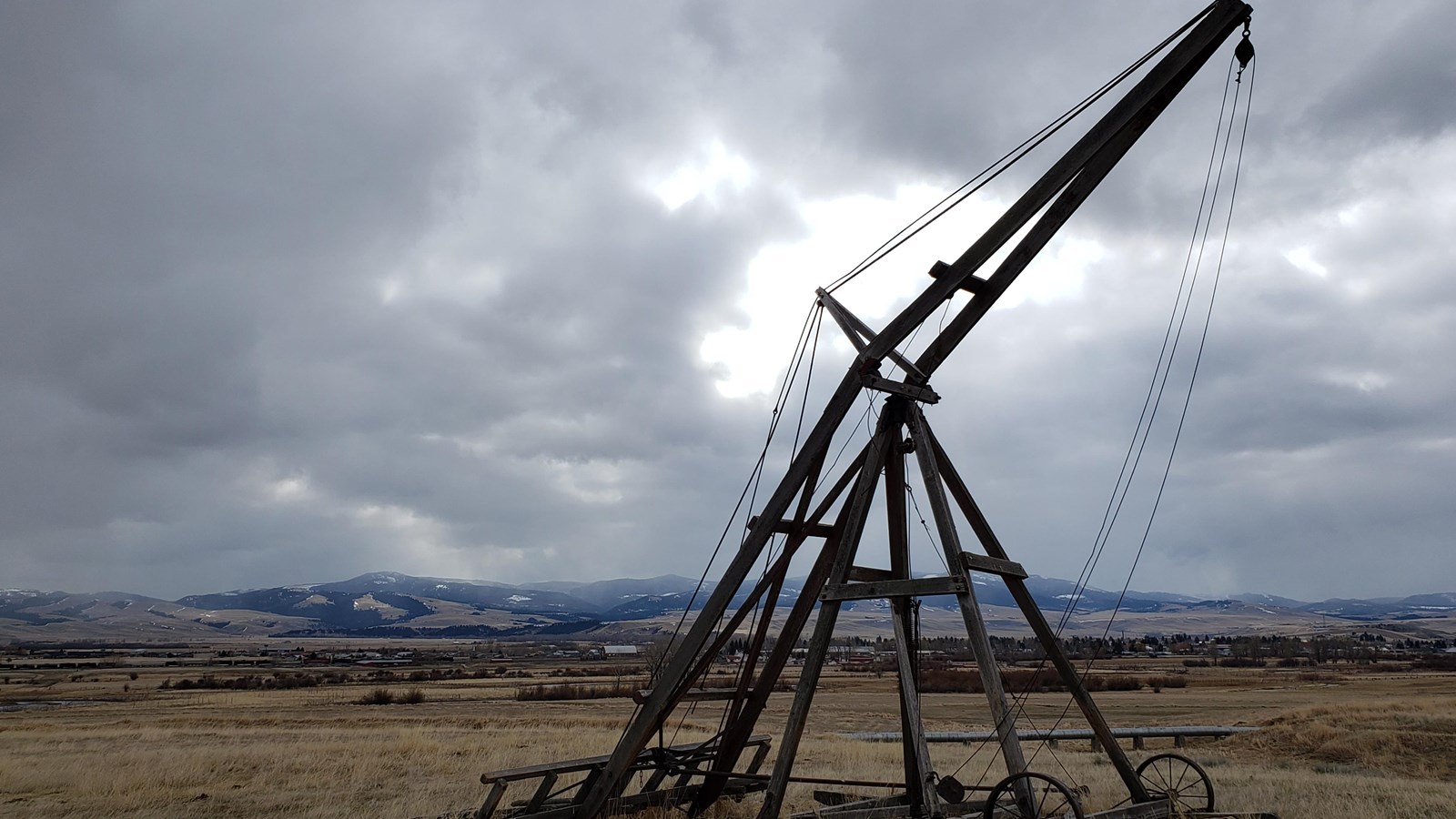Last updated: May 17, 2021
Place
Jenkins Hay Stacker

NPS/C Tongish
Quick Facts
Location:
Grant Kohrs Ranch
Significance:
Historical Structure
Designation:
National Historic Site
Amenities
2 listed
Cellular Signal, Scenic View/Photo Spot
Historically, ranchers had to manually build their large haystacks by using tools such as pitchforks and wagons. This took a great deal of hard work and manual power to stack enough hay to feed their livestock through the harsh winter. Over time more efficient ways to stack hay were developed, which used large machines with cables and pulleys to speed up the process.
This Jenkins hay stacker was patented in 1906 and is an automatic swinging hay stacker, which rotates or pivots to move hay from one location to another and place it in a pile, or haystack. It only required one person and one horse to operate it instead of needing a team of men and horses. The cut hay was placed on the front of the stacker on the fork, which laid on the ground. The person operating the device would then set the pulleys and gears to “control” the movement of the stacker. Once everything was set, the operator guided the horse to pull on the cables. This caused the fork to rise and pivot to one side and dump the hay on to the stack and then return the fork back to the ground, where it was ready for more cut hay to be lifted.
The cutting, stacking, and storing of hay became a critical task on western ranches by the turn of the century. As grazing lands were fenced in to create pastures, livestock needed supplemental feed, especially in the winter months when heavy snows made access to grass more challenging. Just a single cow or single horse can consume 24-27 pounds of hay each day in the winter. While some ranchers in the Open Range Cattle Era were using hay to feed some livestock, the need to prepare and store enough hay for all livestock to survive through harsh winters proved to be a necessity, and not just an option, following the Hard Winter of 1886-1887.
It is also crucial to build and shape the haystacks properly to protect the feed from storms and winter weather. While the outside layer of the hay is exposed to the elements, most of the snow and rain will gently roll off the top and trickle down the sides, which protects the inner layer of hay within the stack from mold and moisture.
This Jenkins hay stacker is a conserved artifact at Grant-Kohrs Ranch and repair and restoration efforts were completed in July of 2004. The work done on the stacker included replacing rotten wooden beams, and rusted iron bolts. The entire hay stacker was also raised off the ground and placed on pedestals to slow down the weathering and decay process of its wooden base.
This Jenkins hay stacker was patented in 1906 and is an automatic swinging hay stacker, which rotates or pivots to move hay from one location to another and place it in a pile, or haystack. It only required one person and one horse to operate it instead of needing a team of men and horses. The cut hay was placed on the front of the stacker on the fork, which laid on the ground. The person operating the device would then set the pulleys and gears to “control” the movement of the stacker. Once everything was set, the operator guided the horse to pull on the cables. This caused the fork to rise and pivot to one side and dump the hay on to the stack and then return the fork back to the ground, where it was ready for more cut hay to be lifted.
The cutting, stacking, and storing of hay became a critical task on western ranches by the turn of the century. As grazing lands were fenced in to create pastures, livestock needed supplemental feed, especially in the winter months when heavy snows made access to grass more challenging. Just a single cow or single horse can consume 24-27 pounds of hay each day in the winter. While some ranchers in the Open Range Cattle Era were using hay to feed some livestock, the need to prepare and store enough hay for all livestock to survive through harsh winters proved to be a necessity, and not just an option, following the Hard Winter of 1886-1887.
It is also crucial to build and shape the haystacks properly to protect the feed from storms and winter weather. While the outside layer of the hay is exposed to the elements, most of the snow and rain will gently roll off the top and trickle down the sides, which protects the inner layer of hay within the stack from mold and moisture.
This Jenkins hay stacker is a conserved artifact at Grant-Kohrs Ranch and repair and restoration efforts were completed in July of 2004. The work done on the stacker included replacing rotten wooden beams, and rusted iron bolts. The entire hay stacker was also raised off the ground and placed on pedestals to slow down the weathering and decay process of its wooden base.
